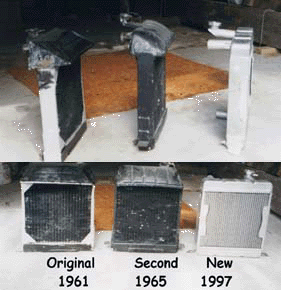 Andover, Ct.
Andover, Ct.
Originally written: March 01, 1999
Last updated: June 16, 2009 Reformatted page
For 36 years and about 100,000 miles my ‘61 +4 had cooling problems. At first it was spitting out coolant and running very hot in stop and go traffic. The temperature gauge usually read near “H” or wasn’t working. I added a ground wire to the radiator, that helped the gauge problem. I also learned to check the coolant level regularly. The temp gauge will not read correctly if the coolant level is low. Driving with low coolant is also a good way to crack the cylinder head, as I learned one cold snowy night. The first indication was less than no heat. It was 11 PM, I was 20 miles from nowhere. Pressing on to home was the only choice. When I shut off in the ignition in the garage the engine wanted to run on. I had to put it in gear and let the clutch out with the break on to kill it. The sound the engine made while cooling off wasn’t pretty.
Over the years the radiator had been repaired several times and for the 5 years I was rebuilding the car, the radiator sat empty. It was over 30 years old and not in the best condition. In 1995 I was able to buy a newer radiator, it also had been stored dry and had a leak, but the price was right. Off to the radiator shop it went to be repaired and flow tested. With the newer radiator installed, an electric fan and an oil cooler I was confident that my cooling problems were over.
Driving around town everything seemed to be working OK. At highway speeds
 the temperature would climb past “H”. The electric fan would turn at 190° but
could not bring the temp down. A coolant recovery bottle was added and the 180°
thermostat was replaced with a 160°. The radiator blew a seam, and was repaired
again. The 7lb pressure cap was replaced with a 4lb cap. We drove 450 miles to
MOG-26, stopping often to cool both ourselves and the car.
the temperature would climb past “H”. The electric fan would turn at 190° but
could not bring the temp down. A coolant recovery bottle was added and the 180°
thermostat was replaced with a 160°. The radiator blew a seam, and was repaired
again. The 7lb pressure cap was replaced with a 4lb cap. We drove 450 miles to
MOG-26, stopping often to cool both ourselves and the car.
I started looking for a replacement, a modern aluminum radiator that could take a 7 to 10lb pressure cap. I made several calls to a company mentioned in Fred Sission’s red book, but got nowhere. Five months later the phone was disconnected.
An article in British Car, Dec ‘96 mentioned Davis racing products in Phoenix AZ, at 1-800-842-5166, and in Circle Track I saw an ad for Griffin Radiator in Piedmont,SC at 1-800-722-3723. I called both Davis and Griffin and was quoted about the same price and delivery time. Wayne Whitfield at Griffin asked me to fax a drawing, he called back within the hour. We talked about my needs, he suggested a 1 row core, I wanted a larger core, and we settled on a 2 row core. Because of the shape of the radiator, taller than wide, it is not a cross flow design. By late January ‘97 I had finalized my drawings, and sent them along with my old rad and my electric fan to Griffin. Wayne called and we discussed the shape of the upper tank.
In mid March the new rad, with the fan mounted on it arrived. It was better than I had hoped, all aluminum, welded and light weight. The dimensions of the radiator are, 14.75” wide, 2” thick, and 16.5” high ( 17.5” to the top of the filler neck. Because I wanted to be able to use the hand crank to turn the engine over, I had the radiator mounting tabs placed on the bottom of the lower tank. But, I miss-measured the height of the rubber shock mounts, and as a result needed to make new radiator mounting brackets. The only other change that I should have made, would be to extend the filler neck one more inch to better clear the cowl and ease filling.
At highway speeds, the alloy rad with a 180° thermostat, 7 LB pressure cap and the oil cooler removed, the engine now runs at 185°-195°. The fan thermostat needs to be changed to turn on/off at a higher temp. The fan turns on at 190° and off at 165°. This means that if the fan turns on in traffic it will not turn off even at highway speed. I have a manual/auto switch and an indicator light to tell when the fan is on. With the new rad the light glows as the fan pinwheels at speeds above 50 MPH. With the old rad the light would come on at 50 MPH but go out above 60 MPH. I take this to indicate better aid flow through the new radiator.
In over 2500 miles of highway and stop and go driving the engine has not over heated and I have not needed to add coolant, the overflow bottle is working. Now for a tasteful air dam to help evacuate the heat from the engine compartment.
Nelson Warner
4751
Return to the Index of Tech. articles
To email Nelson with comments or questions.